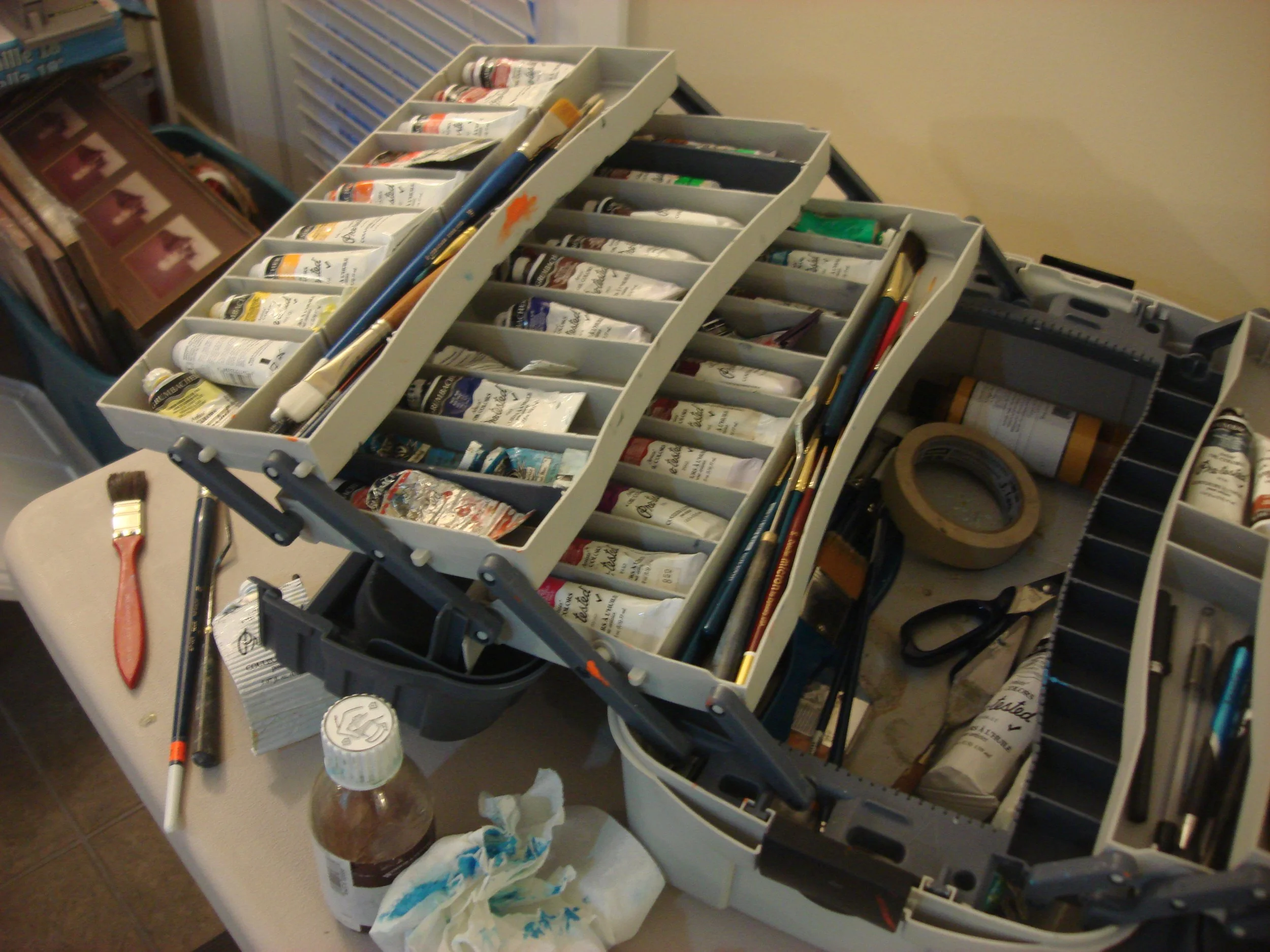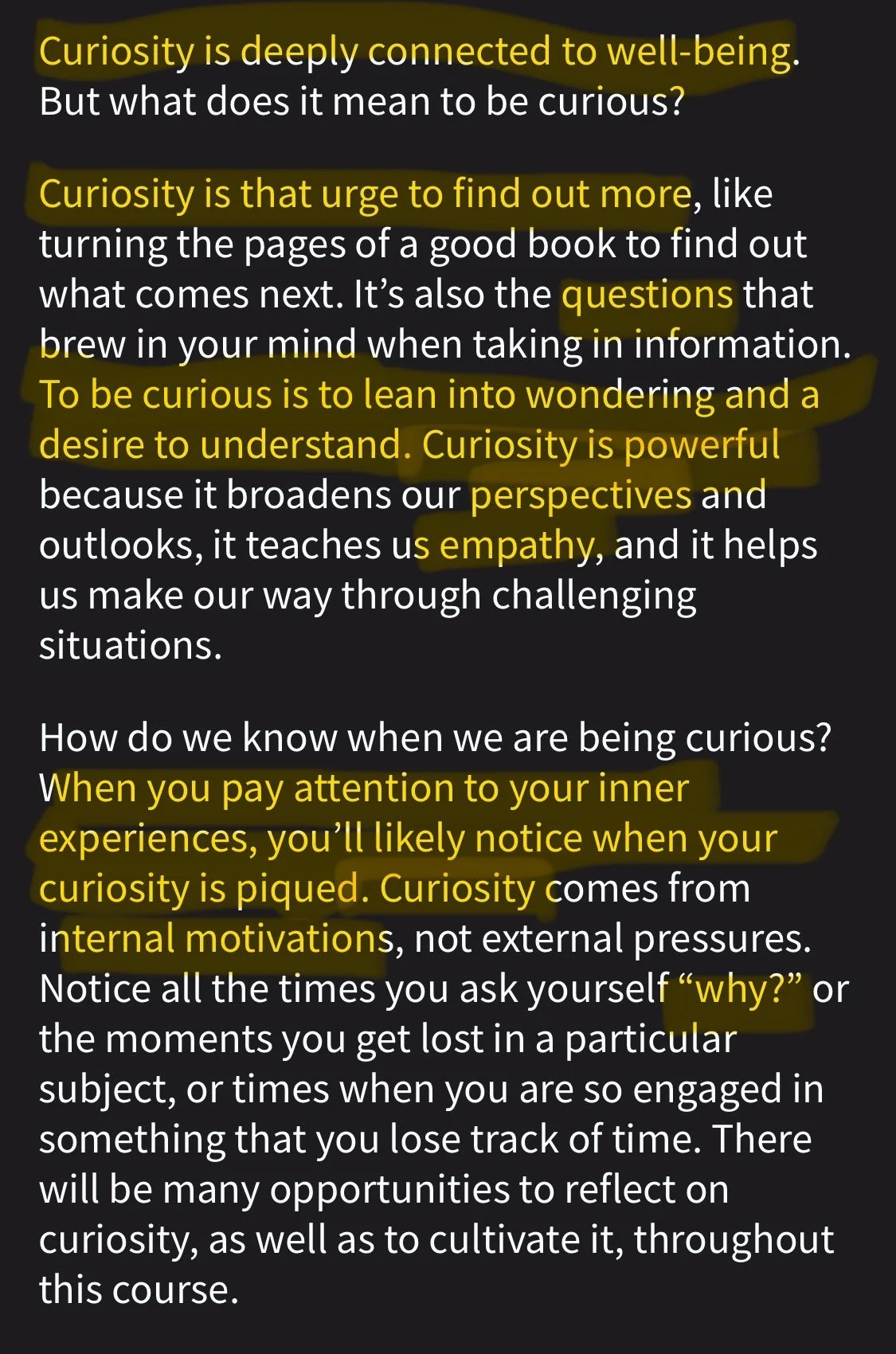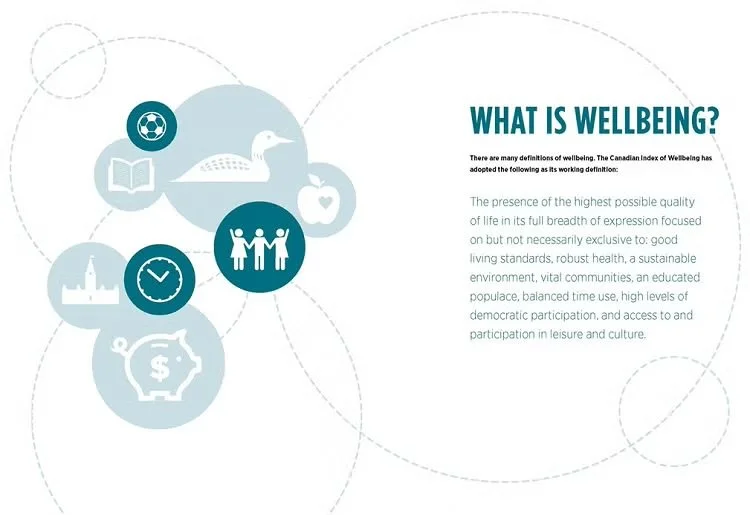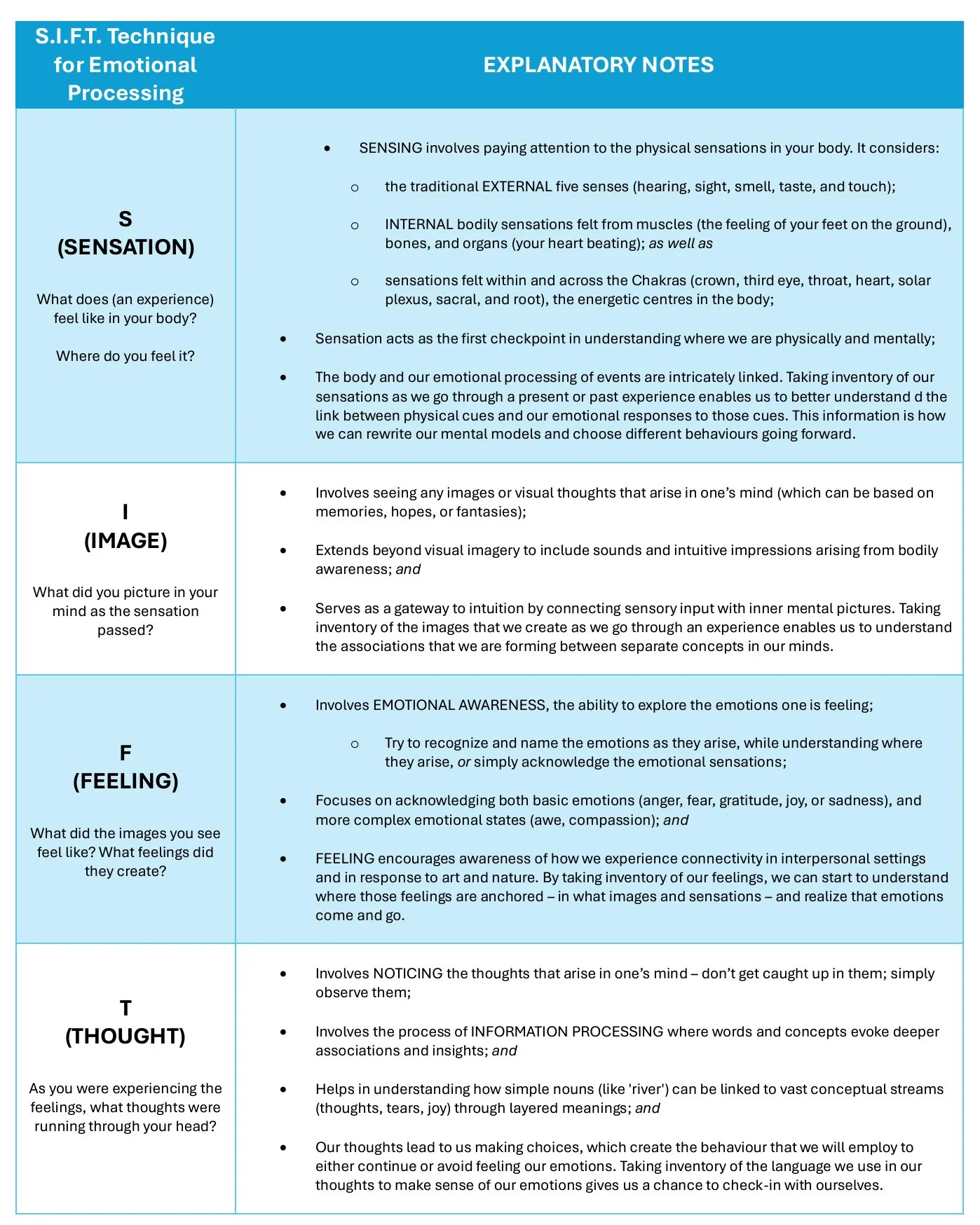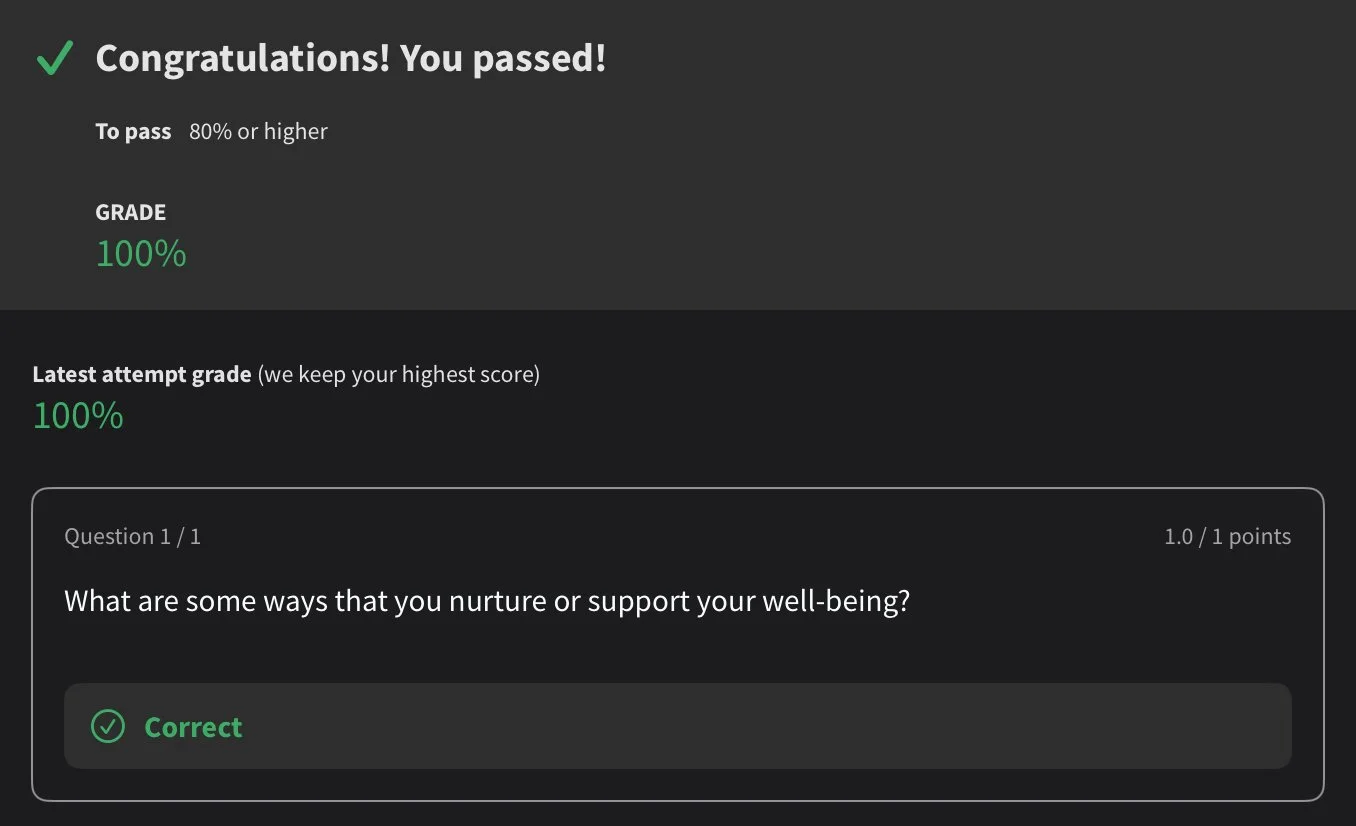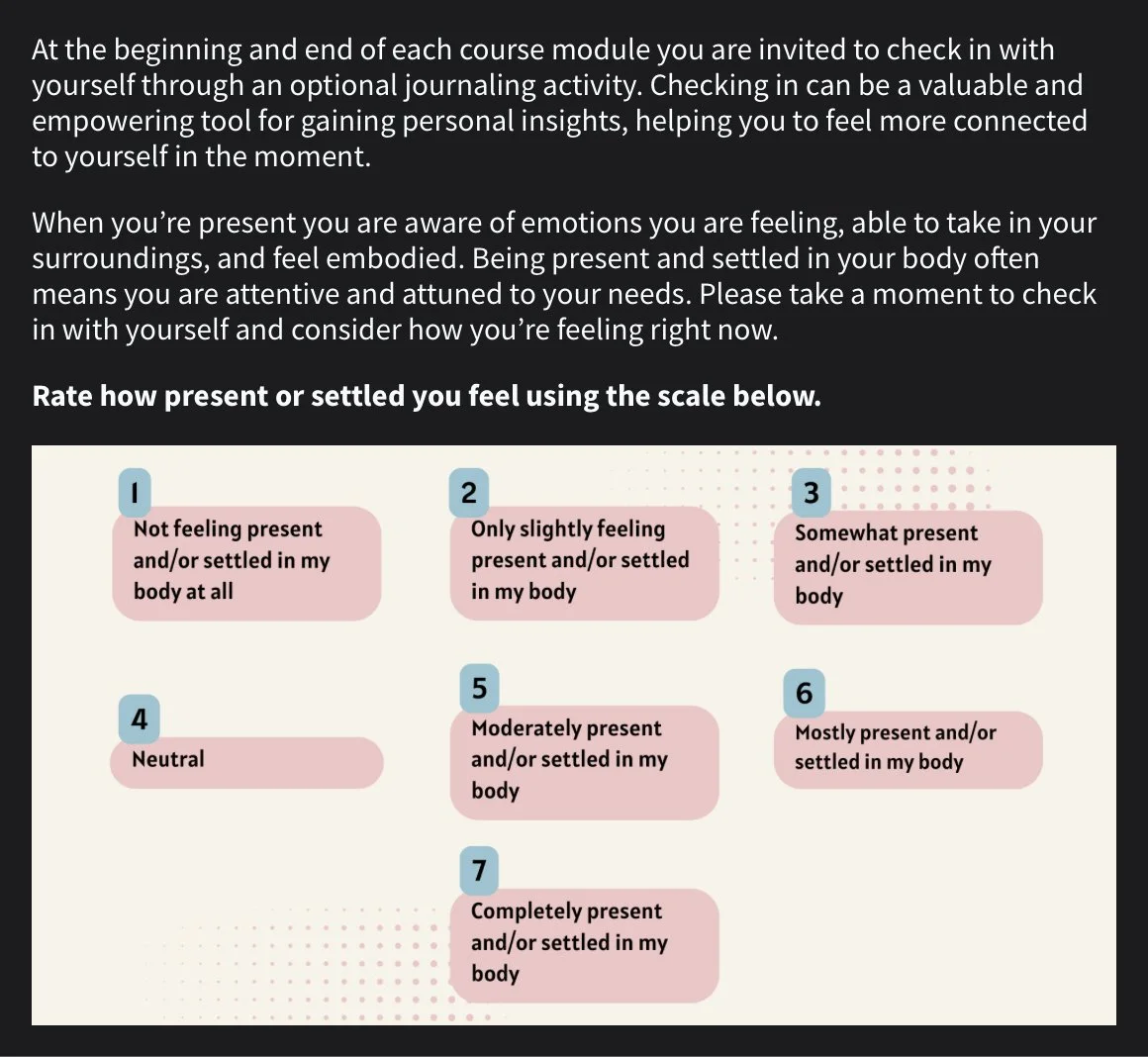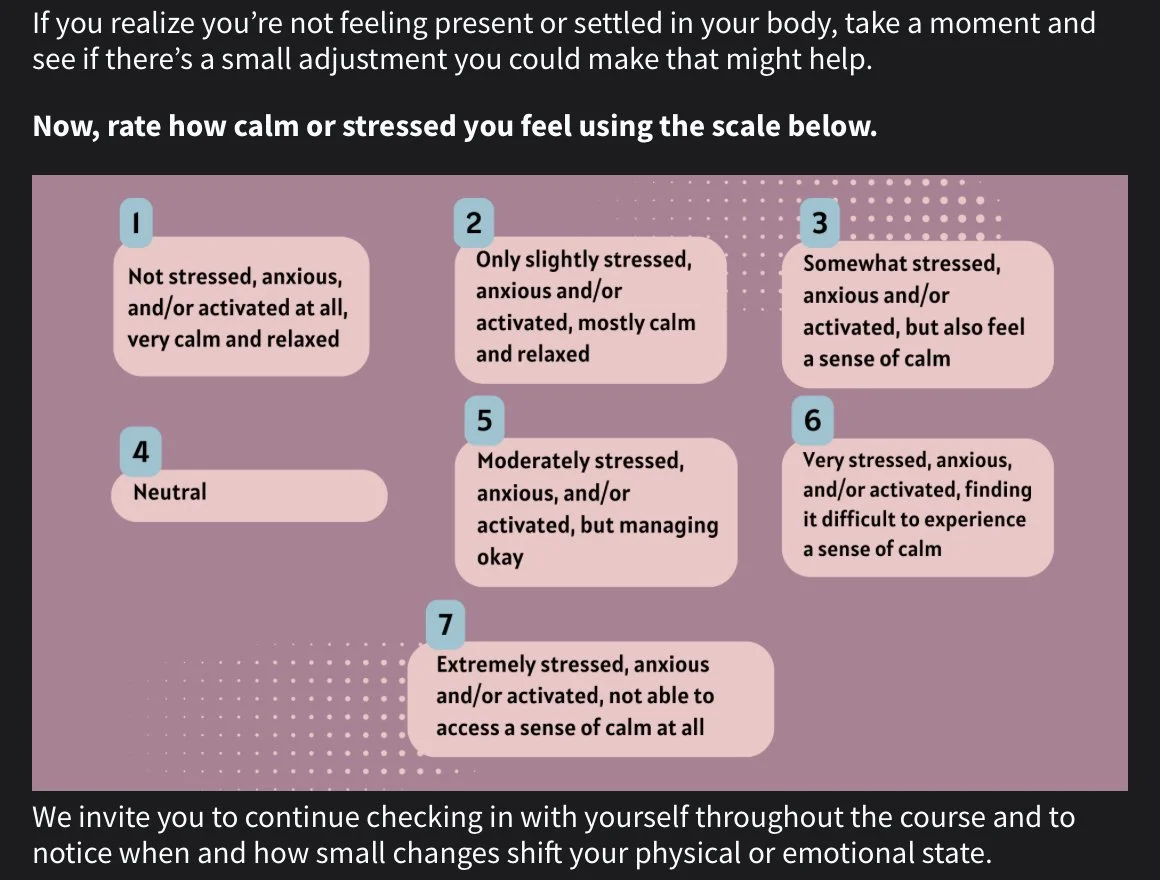WEEK 07 - The Body, Somatics, & Embodiment
WEEK 06 - Rest, Coziness, & Comfort
WEEK 05 - Grief, Loss, & Longing
WEEK 04 - Dreaming, Imagining, & Envisioning
WEEK 03 - Compassion, Gratitude, and Joy
Exploring
How Humour, Playfulness, & Curiosity can be powerful supports for well-being.
The ways artists and artworks use Humour, Playfulness, & curiosity.
WEEK 02 - Humour, Playfulness, & Curiosity
Introduction to Humour, Playfulness, & Curiosity
I) Welcome to Module 2
Curiosity.
Beginners mind.
THINGS AVAILABLE TO US AT ALL TIMES, “…particularly when we feel present and settled in our bodies.”
Curiosity…
allows for responsiveness rather than reactive;
creates space to observe our thoughts, emotions, and behaviours non-judgmentally;
allows us to consider what’s going on inside and around us;
illuminates possibilities;
provides us with choices; and
increases our sense of connection, playfulness, and vitality.
What does it look and feel like when one notices curiosity?
Do you get a rush of excitement when you learn something new?
Do you find yourself asking questions?\
II) Self Check-In
I’m rating myself as being between a 5-6, moderately present and / or settled in my body. I’m tired today, and feeling a bit weak, probably because of too much sugar yesterday.
In terms of feeling calm or stressed, I’m rating myself as a 3, somewhat stressed, anxious, and / or activated, but also feel a sense of calm. I’m a bit rattled, overwhelmed. I had wanted to do more today, such as cut the grass at my Mom’s place, but I ended up napping.
Curious Connection
III) Curious Connections
Ask…
What can happen when we follow our curiosity?
How can curiosity open us to new ideas, perspectives, and actions?
What connections and collaborations might occur that stem from being curious?
ARTIFACT 01 > AGO. “Mindfulness Series: The Human Connection & Curiosity.” YouTube,
IV) Giorgio Lupi & Stefanie Posavec, ‘Dear Data’
Giorgio Lupi & Stefanie Posavec are Italian (living in NYC) and American (living in London) artists who collaborated on a year long project to get to know each other through the compilation and sharing of hand-drawn data postcards.
The project could be laborious and demanding, as well as frustrating. But it made the artists pay attention and live in the present moment with a deeper awareness of their surroundings and their own behaviour.
V) Giorgio Lupi on Humanizing Data
For Lupi, good data collection is rooted in having and cultivating curiosity. Being curious leads to having a sense of openness that impacts all of one’s senses, and a feeling of FLOW. Lupi notes how for her, “Data is nothing more than an abstraction of our reality. A lens, a tool that we can use to filter our reality one subject at a time.”
ARTIFACT 02 > MoMA. “How Giorgio Lupi visualizes life through data.” YouTube, 04 Dec 2024.
ARTIFACT 03 > TED. “What Long COVID Taught Me About Life (and Data) | Georgia Lupi | TED.” YouTube, 17 Oct 2024.
VI) Games and Humour
Humour - what comes to mind when you think about it? The Oxford Language Dictionary defines it as a mood or state of mind, “…the quality of being amusing or comic, especially as expressed in literature or speech.”
The course notes how: “There are many kinds of humor. Benign, gentle, or benevolent humor can help reduce anxiety, boost mood and optimism, release tension, and create a sense of connectedness. Dark humor can help people cope with challenging situations and complex emotions. Finding humor in a dark situation, telling a self-deprecating joke, or making light of a heavy topic are normal as long as no one is being harmed. Humor often offers levity and helps us relate to a situation or feeling in a different way. If we are in emotional distress or physical pain, humor can momentarily shift our attention away from what is causing our suffering, giving us a much-needed break.”
VII) How to See an Exquisite Corpse
VIII) Guadalupe Maravilla, Tripa Chuca
IX) Optional Creative Prompts
Fun with Language
X) Fun with Language
XI) Artist Inspiration: Mikel Shiomi’s Instructions
XII) Artist Inspiration: Ed Ruscha’s Wordplay
XIII) Cecilia Vicuña, Amazon’s Palabrarmas
XIV) Optional Creative Prompts
Playing with Everyday Materials
XV) Playing with Everyday Materials
XVI) Artist Inspiration: Making the Everyday Unfamiliar
XVII) Optional Creative Prompts
Review and Reflect
XVIII) Reflection on Week 2
XIX) Optional Readings and Resources
Below are optional readings and resources that provide enhanced context for the concepts and artworks featured in the course. You can complete the course without reviewing them.
Course videos on YouTube
Curiosity
Jennifer Gerlach, The Curious Mind: A Key to Mental Wellness, Psychology Today, published September 14, 2023. This article highlights the benefits of having a curious mind and the ways you can cultivate a sense of curiosity.
Celeste Kidd and Benjamin Y. Hayden, The psychology and neuroscience of curiosity, National Library of Medicine: National Center for Biotechnology Information, published November 4, 2015. A science oriented article that explores brain development and evolution related to curiosity. This journal article also discusses early childhood development, play and learning with a focus on curiosity.
Todd Kashdan, 5 Benefits of Curiosity, Experience Life by Life Time, published September 1, 2019. According to this article, there are 5 ways curiosity enhances our sense of well-being: health, intelligence, social relationships, happiness, and meaning. This article also gives some helpful ways to intentionally bring more curiosity into your life, such as finding the unfamiliar in the familiar.
David Robson, Curiosity: The neglected trait that drives success, BBC, published September 6, 2022. This article explores how curiosity about a subject can boost success. Neurological changes take place when we are curious and information we take in is often more deeply encoded. Robson also shares how curiosity can also provide a memory boost.
Scott Shigeoka, How Curiosity Can Help Us Overcome Disconnection, Greater Good Magazine, published September 27, 2023. Shigeoka discusses the way curiosity can help overcome disconnection. Curiosity opens up people to hearing from different perspectives, stories, ideas, and seeing the humanity in others, all of which builds connection. This article also gives some useful tips for letting go of biases and assumptions in order to let in curiosity.
Humor
Eric Dolan, New study identifies which types of humor are linked to reduced worry and increased well-being, PsyPost, published November 24, 2021. This article breaks down some of the key findings in a study about humor, concluding that people who engage with fun and benevolent humor have higher levels of psychological well-being.
Angela Haupt, Humor Has Health Benefits. How to Add More to Your Life, TIME, published May 8, 2023. An article that offers a few suggestions about how to cultivate more humor in your life.
Ilona Papousek, Humor and well-being: A little less is quite enough, International Journal of Humor Research, published February 2018. A scholarly article that examines the types of humor that are most impactful to well-being. The article sheds light on the physical and emotional responses to some types of humor, asserting that humor is not a miracle cure all but a great tool to have in your toolbox.
Jared C. Pistoia, Can You Use Humor as a Coping Mechanism?, Psych Central, published June 22, 2024. This article refers to several reviews that examine the ways humor can be used. The article compares positive and negative forms of humor and notes the importance of remembering cultural differences in how humor is received.
Brandon M. Savage, Heidi L. Lujan, Raghavendar R. Thipparthi, and Stephen E. DiCarlo, Humor, laughter, learning, and health: A brief review, Advances in Physiology Education, July 5, 2017. A very thorough article that explores humor in medicine, humor and learning, and social bonds that can form through humor, as well as the psychophysiological benefit of humor.
The Show of Delights, This American Life, aired January 31, 2020. Reporter Bim Adewunmi hosts an episode made up entirely of stories about delight, from pure joy to bittersweet moments.
Play and Playfulness
Gwen Gordon, Well Played: The Origins and Future of Playfulness, American Journal of Play, 2014. This article explores research on play and well-being across several disciplines including positive psychology, attachment theory, and neuroscience.
Alison Tonkin and Julia Whitaker, Play and playfulness for health and wellbeing: A panacea for mitigating the impact of coronavirus, National Library of Medicine, National Center for Biotechnology Information, published March 19, 2021. This article explores how play and playfulness in support of well-being as well as questions about why humans play, what play can do, and the value of play.
Kirsty Rigg, Discover the wellbeing benefits of adult play, Happiful, published November 5, 2022. A short article emphasizing the adult need to engage in play for well-being.]
XX) Week 02 Practice Quiz
What’s one way that curiosity has supported your well-being?
In January 2023, I had a stroke..
How it happened
Crying
Becoming curious - working on COURSERA, creative in isolation
XXI) Optional Prompts for Discussion and Reflection
What is your biggest takeaway from this module?
What resonated the most with you? What surprised you and/or got you thinking?
What have you found gets in the way of experiencing humor, playfulness, and curiosity in your life? Are there things you can do to add more humor, playfulness, and curiosity to your life?
When you think about humor, playfulness, and curiosity, after completing this module, how do you see them impacting your well-being, either separately or together?
What’s something from this module you are still thinking about or interested in exploring more deeply?
Did you try one of the creative prompts for the playful connections section? Did one of the artists in this module spark something new for you?
Did you try one of the creative prompts for the fun with language section? Did one of the artists in this module spark something new for you?
Did you try one of the creative prompts for the taking inspiration section? Did one of the artists in this module spark something new for you?
XXII) Self Check-In
Introduction
What does well-being mean to you?
What are the connections between art & well-being?
WEEK 01 - Welcome
MoMA: Artful Practices for Well-Being
Introduction
In May 2025, I embarked on an exploration of Artful Practices for Well-Being as offered by the Museum of Modern Art (MoMA) on the Coursera learning platform. I started it as a way of exploring my personal interests in the intersections of art, mental health and wellness, and mindfulness studies. This online journal will exist as a repository of my notes, exercises, written reflections, and other related resources I find online that have relevance to the conversations this course raises.
I) Welcome to the COURSE
From the beginning… the Coursera website introduced the course as follows…
Welcome to Artful Practices for Well-Being!
We’re glad you’re here! 🤗
If you’ve found your way to this course, it’s likely that you’re aware of or have become curious about the many roles art can play in our lives and how it can impact our well-being.
What can art do for us?
Art is so much more than viewing a work of art in a gallery or museum. Art can help us sit with difficult emotions, experiences, thoughts, and sensations. It can also help deepen our self-awareness while encouraging us to give attention to new perspectives and ideas.
Art can be there for us when words fail, supporting a form of communication that taps into the unconscious and is felt in the body. It can act as a container, holding our emotions and experiences, and teach us how to witness feelings and events from an embodied place. Through art we can learn to regulate our emotions, be still, slow down, ask questions, connect with others, and move through life with more presence.
Take this course at your own pace
Although the weekly modules are numbered, this course is designed to be taken in any order. You are free to go back and forth, retrace your steps, jump ahead, or step back. The pace and approach you take are up to you. Ask yourself questions such as “What do I need right now?” and “How am I feeling?” and let your answers guide you. You won’t find a lot of art historical information in this course, but you will discover many ways to engage with art that can support well-being and personal growth.
If you have enrolled to receive a certificate for this course, you may still explore the modules in any order, but you will need to complete all items, including a practice quiz at the end of each module.
In this course
You’ll hear from a range of practitioners who have found inspiration in art and identified ways to bring art into their daily lives. You’ll have opportunities to share with other learners in the discussion forums. As you explore, we invite you to notice what resonates with you and what you want to bring with you into your life.
We’re excited to have you on this journey with us!
The Artful Practices for Well-Being Course Team
ARTIFACT 01 > Art in Healthcare. “How do art workshops help health and wellbeing?” YouTube, 12 Jan 2022.
Summary of Artifact 01
Creative activities offer a mindful escape from stress and pain, wherein art acts as therapy.
Art provides emotional resilience as it helps recharge mental energy, aiding recovery from difficult situations.
Regular art sessions provides opportunities for social connection, as they foster community bonding and natural conversation.
Consistent participation builds a routine that supports mental well-being through the development of routine and purpose.
Benefits and Mental Well-Being
Mindful Immersion: Engaging in creative art allows individuals to lose themselves in repetitive, absorbing actions that distract from everyday hardships.
Recharge and Recovery: The process is likened to charging a battery, giving participants strength to tackle personal challenges.
Personal Transformation
Therapeutic Impact: Personal accounts reveal that art provided a vital outlet during times of grief and mental distress.
Sub-point: One participant shared how art sessions helped after the loss of a loved one.
Enhanced Focus: Regular workshops helped in planning creative sessions and focusing on recovery.
Social and Community Aspects
Building Bonds: Participation in group sessions encourages natural conversations and mutual support.
Leadership and Growth: Initial hesitations in group settings often evolve into increased confidence and leadership among participants.
Flexibility and Adaptability
Diverse Participation Options: Attendees can either immerse themselves quietly or engage more interactively in structured classes.
Adaptation During Lockdown: The shift to Zoom sessions maintained community cohesion when in-person meetings were not possible.
II) A 🎵 on CuRiOsItY…
ARTIFACT 02 > Screenshot from the Coursera discussion of “A note on curiosity” with highlights by Steven Lee.
To be CURIOUS is to have an eagerness to KNOW, UNDERSTAND, or LEARN something. CURIOUSNESS is the expression of CURIOSITY.
Being CURIOUS involves taking the time to notice carefully, deeply and thoughtfully.
ARTIFACT 03 > The Personal Growth Path. “What is the Meaning of Curiosity? - The Personal Growth Path.” YouTube, 15 Feb 2025.
Summary of Artifact 02
Curiosity is defined as a persistent trait driving the desire for new knowledge and experiences.
The video outlines two Core Aspects of curiosity: Exploration (seeking new experiences) and Absorption (fully engaging in them).
Curiosity has positive impacts including: an enhanced well-being, a reduction in uncertainty, and a boost in intellectual growth.
Overall, curiosity encompasses deprivation sensitivity, joyous exploration, social curiosity, and stress tolerance.
Definition of Curiosity: Described as our innate tendency to seek out and enjoy new information and experiences; a constant part of our personality.
Core Aspects
Exploration: Actively pursuing novel experiences and ideas.
Absorption: Becoming deeply engaged in these experiences.
Impact on Wellbeing and Learning
Curiosity links to positive emotions and pleasure in acquiring knowledge.
Helps reduce feelings of uncertainty by filling knowledge gaps and restoring coherence.
Dimensions of Curiosity
Deprivation Sensitivity: Recognizing and addressing gaps in knowledge.
Joyous Exploration: Enjoying the act of discovering new things.
Social Curiosity: Learning about others through observation, conversation, and listening.
Stress Tolerance: Managing the anxiety that can arise with exploring new concepts.
Benefits of Being Curious
Encourages personal and intellectual development.
Highly curious individuals tend to perform better, persevere more, and achieve more meaningful goals (e.g., higher intelligence scores in children).
III) What does WELL-BEING mean to you?
Well-being means to me…
Being mindful;
Having a focus on wellness while maintaining a soundness of one’s own body, mind, and spirit;
Cultivating a middle way, that is, a grounded nature where one can be emotionally aware of what they are feeling, why they are feeling it, and how they react to what they are feeling; and
Understanding one’s intentions behind how they choose to act, especially when related to how they feel.
——
The Oxford dictionary defines WELL-BEING as: “…the state of being comfortable, healthy, or happy.”
Google AI summarized well-being as follows: “Well-being, or sometimes spelled as "well-being," refers to the state of being healthy, happy, and prosperous. It encompasses various aspects of life, including physical, mental, social, and emotional health, as well as overall life satisfaction.
Key aspects of well-being:
Physical health: This includes having a healthy body, being active, and taking care of your physical needs.
Mental health: This refers to your emotional state, including your ability to manage stress, cope with challenges, and maintain a positive outlook.
Social well-being: This involves having strong relationships with others, feeling connected, and contributing to your community.
Emotional well-being: This relates to your ability to recognize and manage your emotions, build resilience, and maintain a positive self-image.
Spiritual well-being: This refers to your sense of meaning and purpose in life, your beliefs, and your connection to something larger than yourself.”
Wikipedia describes how: “Well-being is what is ultimately good for a person. Also called "welfare" and "quality of life", it is a measure of how well life is going for someone. It is a central goal of many individual and societal endeavors.”
The same Wikipedia article then discusses how well-being can be broken down into two parts, subjective well-being and objective well-being, noting how: “Subjective well-being refers to how a person feels about and evaluates their life. Objective well-being encompasses factors that can be assessed from an external perspective, such as health, income, and security. Individual well-being concerns the quality of life of a particular person, whereas community well-being measures how well a group of people functions and thrives. Various types of well-being are categorized based on the domain of life to which they belong, such as physical, psychological, emotional, social, and economic well-being.“
The University of Waterloo defines Well-being as outlined in Artifact 04 below…
ARTIFACT 04 > University of Waterloo. “What is Well-being?”
The Live Well website describes several core concepts related to health and well being as presented in a health and wellbeing circle, showcased as follows in Artifact 05…
ARTIFACT 05 > Live Well. “The health and wellbeing circle.”
The Self-Care Forum breaks down a straightforward overview of how to maintain one’s mental health and well being, as illustrated below in Artifact 06…
ARTIFACT 06 > The Self-Care Forum. “Personal Wellbeing | Mental Health and wellbeing.”
SEE: Ellis, Susie. “Wellness, Well-Being… and What About Spa?” Huffington Post, 13 APR 2016.
Sifting through Feelings and Experiences
I) S.I.F.T. With Dr Dan Siegel
Dr Dan Siegel also introduces the SIFT process (Sensation, Image, Feeling, Thought) is used to explore and integrate experiences. SIFT is about taking an inventory of the sensations, images, feelings, and thoughts that are passing through us at any given moment.
With this process, the emphasis on being present, connecting bodily sensations with emotions and thoughts.
Curiosity drives both simple observations (e.g., a snail’s shell) and deep existential questions.
Curiosity exists as the Essence of Wonder, as it:
Describes curiosity as a beautiful capacity to explore both concrete phenomena and broader concepts like the nature of reality, energy, and time.
Highlights that curiosity is not limited to external observations but also extends to inner explorations.
Siegel coined the term interpersonal neurobiology to capture the interplay between our bodily existence and our interconnected social lives. This emphasizes the dual aspects of being: the physical (body sensations) and the personal (relationships and inner experiences).
The SIFT Process Explained
The SIFT technique, developed by Dr. Dan Siegel, is a mindfulness-based tool used to process and understand emotions. It involves noticing sensations, images, feelings, and thoughts in a systematic way. This technique helps individuals become more aware of their inner experience, especially when dealing with strong emotions or difficult situations.
Specifically, SIFT is about taking an inventory of the sensations, images, feelings, and thoughts that are passing through us at any given moment.
ARTIFACT 08 > Lee, Steven. “The SIFT Technique for Emotional Processing.”
Application and Integration in Daily Life:
By systematically noticing these aspects of your inner experience, the SIFT technique helps you understand the complex interplay of sensations, emotions, and thoughts, which can be particularly helpful for managing anxiety, stress, and other strong emotions. According to Dr. Siegel, this technique can also improve emotional regulation, resilience, and decision-making skills.
Siegel recommends using the SIFT method in various situations, such as at art museums, to enhance personal awareness and engagement with the present moment.
Suggests that differentiating and then connecting sensations, images, feelings, and thoughts can deepen self-understanding and foster a richer experience of life.
Highlights the flexibility of the process—while the order of SIFT elements is not rigid, the practice of introspection is key to gaining insights.
Philosophical Reflections:
The discussion frames the SIFT process as a method for navigating uncertainty and exploring the intricate balance between internal needs and external connections.
Art, in its various forms, is presented as a medium that invites individuals to sift through their experiences in order to expand their sense of self and awareness of the world.
II) Art May Cause you to Feel
The course website notes how one can:
Get ready to take an imaginary trip through MoMA’s galleries with mental health illustrator Lindsay Braman as she reflects on how art can elicit emotion.
As you take your time exploring Lindsay Braman’s illustration of emotions, consider:
Are there any emotions that you relate to more than others?
Are there any emotions that are unfamiliar to you or that you don’t experience often?
Pay attention to any bodily sensations or thoughts that come up as you explore the different emotions highlighted in this piece. What information might they be giving you?
I listen for emotion and coax it forward to a space where it can be cared for, known, and expressed without judgment.
Often, through learning to notice our emotions without judgment, they’re transformed. The foreign becomes familiar as exiled emotions become companions—neither good nor bad, simply present. This panel creates a place where many of the emotions we experience in response to art can exist with a name, a face, and an imagined embodiment.
ARTIFACT 07 > Lindsay Braman. Caution: Art May Cause You to Feel. 2022. Original illustration created for MoMA. © Lindsay Braman.
Braman asks us to consider these questions when engaging with art and emotion:
What artwork(s) make me feel curious?
What artwork(s) make me feel peaceful?
What artwork(s) make me feel skeptical?
What artwork(s) make me feel delighted?
HOW DOES ART MAKE YOU FEEL? WHY?
Review and Reflect
I) Reflect on Module 01
In Module 1 you considered what well-being means to yourself and others. We encourage you to pay attention to whether your idea of well-being shifts as you move through this course. There are several optional resources in this module to stimulate your thinking about well-being, and you are encouraged to refer to them throughout the course.
You also heard from Dr. Dan Siegel about how you might S.I.F.T. through your emotions and experiences. You learned from mental health illustrator Lindsay Braman’s as she reflected on the power art has to make us feel different emotions.
We invite you to independently reflect, using any method that feels right for you:
Describe a time when you experienced a work of art that prompted an unexpected emotion. What emotion(s) arose for you? How did you respond?
What’s one practice you currently engage in that you feel supports your well-being?
What’s one artistic practice or artful approach that you’d like to try that you feel might enhance your well-being?
Does the S.I.F.T. approach resonate with you? Can you think of an example from this week where using S.I.F.T. might have been helpful to you?
What are you most curious to discover about yourself in this course?
You can record your response in writing, drawing, photography, or collage一whatever feels right to you! Don’t worry if you don’t have a complete picture yet, we’ll return to these questions at the end of the course.
In 2022, I was able to spend an afternoon looking at the work of artist Yoko Ono on display at the Vancouver Art Gallery in British Columbia, Canada. One part of the exhibition, RISING: A CALL actually moved me to tears. It was a gut wrenching display of row after row of testimonials printed Oman to single blank letter sized pages. Above each block of text appeared a closeup snap shot of a single pair of eyes. The testimonials were by the survivors of sexual assault. Rape. The eyes were definitely the eyes of survivors, where I felt as though they had found an inner sense of strength again, while others felt as though they were still broken with grief, lost in the pain of the memory of what they had endured. They were not weak per se, but vulnerable, each on their own journey of grief where in they were dealing with the abuse they had endured. The stories were not easy to read. I felt a chill run through me. For some, it was a single act of abuse. For others, generational abuses. One survivor’s perpetrator was her grandfather. Another, her father. And another, her boyfriend. But what took me aback was when I immediately recognized the eyes of one of the stories that had been shared. The chances of this happening shouldn’t be shocking, as the statistics are sadly very clear - in the United States alone, 1 out of 6 women have been the victim of an attempted or completed rape in her lifetime (and this number is 1 out of 33 for men). And these numbers are likely very conservative, as over sixty percent of sexual assaults go unreported to the police. I nervously reached out to my friend a few days after seeing the show, to confirm that it was indeed her that I had seen, and it was. I did the bare minimum I knew to do, I apologized for her having to have experienced what she did. And this is why I was so moved to tears, and felt like I had been punched in the gut - because one of these very personal stories hit closer to home simply because I knew the survivor.
Right now, I haven’t been engaging in any practices that support my well-being. Or so it feels that way. But that’s not entirely true. I have been trying my best to eat healthier. I’m trying to cut back on sugary drinks and junk food, especially baked goods like cakes, donuts and cookies. I haven’t been perfect at doing this, I had a chocolate chip cookie at Starbucks last Tuesday, followed by a Peanut Buster Parfait and a Small Dipped Ice Cream Cone at Dairy Queen. I think I had several sweetened ice teas, maybe even a cola. The next day the neuropathy really hit me hard in my hands and the pain was excruciating. I looked up vitamins and minerals that I could take to help ease the pain and get the blood flowing again - and I went out to get those and I’ve been taking them since. But yesterday, I had a bowl of Ice Cream. Today I had Key Lime Pie. These are not foods that will help my well-being physically. They spike my blood sugar levels and leave me feeling exhausted. They send pain shooting through my hands and feet. Right now, I’m snacking on some almonds with a large iced green tea, unsweetened. I’m also sipping on a hot chocolate which only has one pump of chocolate syrup in it so it tastes more like warm milk than hot chocolate. I can eat better, I can cut out the sweets, even if it’s one day at a time.
I’d like to get out into nature more and do more photo walks, where I’m moving more slowly, first and foremost enjoying the present moment but not necessarily worrying about getting the perfect shot. If I see something that catches my attention, maybe some Rhododendron flowers for example, I’d like to spend time just looking, before raising my camera to record them for prosperity. Sketching would be nice too, I haven’t really done that often when on a nature walk.
The S.I.F.T. Process felt very close to the kinds of practices one explores when they work to be more mindful. Sensing both internally and externally, is an important part of being emotionally aware, especially when it comes to understanding what one feels, and why. It feels very much to be rooted in fostering a mind body connection, as you become closer to understanding what you feel in your body, and how that can create images and thoughts in one’s mind. The images and thoughts are what lead to one making choices on how to act on what they feel. An example from this week where the SIFT process may have helped me be more mindful was in regards to a game I play, Pokémon Go, where if a pocket monster I’m trying to catch keeps escaping, I get angry and yell at my smart phone. When this happens, I always feel stupid, but now I’m catching myself when I get frustrated and I’m becoming less angry as a result. Ideally, I’d love to be able to not get angry at all, because at the end of the day, it’s only a game.
By taking this course, I’d love to be able to find new ways of cultivating the connections that can exist between myself, art, and being more mindful and loving towards myself. I’m curious to discover if I can really become more grounded and mindful as I move through life in the present moment.
II) Optional Readings and Resources
Artful Practices for Well-Being
The inspiration for this course on Artful Practices for Well-Being comes from a MoMA initiative that includes Magazine features, audio playlists, a museum visit itinerary, as well as programs like Slow Looking and Writing Club that seek to meet people where they are, without exception or judgment.
Artful Practices for Well-Being acknowledges that every individual is an expert on their own life. We also recognize the importance of the collective, as we are all interconnected and impacted by one another. We intentionally chose the word well-being over wellness or health because it offers a more open and inclusive meaning. Well-being recognizes that we are all more than our physical and mental health, and we can define our sense of well-being for ourselves.
Below are optional readings and resources that offer more information about distinguishing between well-being and wellness. You can complete the course without reviewing them.
Well-Being
David S. Baldwin and Gemma Simons, A critical review of the definition of ‘well-being’ for doctors and their patients in a post-Covid-19 era,The International Journal of Social Psychiatry, published July 9, 2021. There is no consensus worldwide on the definition of well-being. This article seeks to come up with an inclusive, global definition of well-being by examining various components and philosophies of it. The subjective nature of the term well-being is also discussed.
John H. Falk, “Why Well-Being is at the Heart of Museum Experiences,” American Alliance of Museums Blog, published January 10, 2022. Based on his research, Falk explores how museums are places where people pursue well-being. He breaks down well-being into four distinct areas: personal, intellectual, social, and physical. This post also considers the value of well-being and possible ways to measure the experience and sense of well-being that people may derive from being at a museum.
Kira M. Newman, Three New Ideas About Happiness and Well-Being, Greater Good Magazine, published August 7, 2023. This article examines well-being and happiness and questions the limiting Western perspectives that have often been placed on this discussion. Psychological richness, balance and harmony, and connection to your culture are three areas of focus in this piece.
Dr. Dan Siegel, Brain Insights and Well-Being, Dr. Dan Siegel: Inspire to Rewire, published September 16, 2014. A short article that describes the significance of integration and relational experiences on well-being.
Jill Suttie, Why Taking Care of Your Own Well-Being Helps Others, Greater Good Magazine, published March 23, 2020. This article talks about the importance of nurturing our own sense of well-being and the ripple effect that it can have on others.
Wellness
Eloise Hendy, A Clean Break: The wellness industry isn’t well, and people are finally waking up to it,The Independent, published January 18, 2023. This article focuses on the products and economic aspects of the wellness industry and how people can fall prey to marketing around ideas of self-improvement.
Sadhbh O’Sullivan, Wellness Culture Won’t Save Us. It’s Only Making Us More Sick, Refinery 29, published January 11, 2023. In this article, O’Sullivan discusses how the wellness industry is focused on the self and the perils that it faces. As outlined in this article, the wellness industry feeds on people’s discontent with themselves, taking and commodifying practices from cultures around the globe.
Shana Moulton and Erika Papernik-Shimizu. Shana Moulton’s Meta/Physical Therapy, MoMA Magazine, published February 15, 2024. This is an interview between artist Shana Moulton and MoMA curator Erika Papernik-Shimizu about Moulton’s study of the material culture around care and healing, which, combined with her use of magical realism and humor, points to how surreal being in a body—in all of its pleasure, pain, and chaos—can feel.
Adrienne Selko, Time to Move from Wellness to Well-Being, EHS Today, published January 31, 2022. Selko discusses wellness resources in the work environment and explains how it’s important to make a shift to prioritizing well-being because it considers the whole person. A big part of well-being is psychological safety and taking care of one’s mental health. Shifts in workplace culture where well-being is focused on have positive impacts on individual employees and across organizations.
Brad Stulberg, We’ve Reached Peak Wellness. Most of It Is Nonsense, Outside Online, published May 12, 2022. This article explores the wellness industry, suggesting that the biggest driver of a sense of well-being is having purpose.
Optional resources
Lindsay Braman’s website is a treasure trove of information about mental health, trauma, and well-being. Her infographics and other images effectively convey complex ideas.
Compasspoint, Self-Care as a Radical Act of Liberation, published 2019–2020. This is an excellent resource on ways of practicing self-care that support liberation. This PDF outlines goals, assumptions, and agreements, provides definitions, and offers many activities.
School of the Art Institute, John M. Flaxman Library, Radical Self Care, Learn & Unlearn: Anti-Racism Resource Guide, published February 2022. A short post on what radical self-care does and doesn't mean.
III) Module I Practice Quiz
What are some ways that you nurture or support your well-being?
In recent years I haven’t nurtured or supported my well-being very effectively. I often turn to unhealthy fast and other junk food, as well as sugary drinks to help drown the anxiety and major depression I have experienced like an ocean, moving from moments of peaceful calm, to foggy overcast days, to horribly stormy swells over the course of my life. My health has not been well as a result. In the early 2010s I developed fatty liver disease, I was overweight, and I developed type 2 diabetes. I also developed high blood pressure, and had a stroke in January 2023 that my doctor said should have probably killed me. Since the stroke, I’ve had a lot of issues with my legs and feet, where wounds didn’t heal easily and then I took to picking at them, prolonging the time it took for them to heal. I’ve eaten more junk and the diabetes has worsened, my daily blood sugar readings are often very high and in recent months I believe I’ve developed diabetic neuropathy in my hands and feet. I’m trying to be more mindful though, as my health has not been well, and I want to feel good again - both physically and mentally.
When I have worked towards nurturing and supporting my well-being, I have:
Worked on turning my focus back to my breath in moments of anxiousness and stress (four to five times where I breathe in through my nose, hold for a few seconds, and then breathe out through my mouth);
Done light stretching in the morning, before getting out of bed, after I have woken up;
Meditated in the morning, after I’ve done the light stretching;
Recited and meditated on the Just for Today principles of Reiki;
Set an overall intention for the day which becomes the focus of my meditation;
Worked on my morning pages journaling practice, as advocated for by author Julia Cameron, in The Artist’s Way, after my meditation;
At the end of the morning pages journaling I would write three things I was grateful for and a short sentence about why I was grateful for those things;
I also tried to map out a few goals for the day in my morning pages journaling;
Brushed my teeth, had a shower, and weighed myself in the mornings;
Taken my medication and vitamins on time in the mornings;
Eaten a protein-rich breakfast when I wasn’t doing an intermittent fasting program;
Used my breath as a point of focus during times I felt overwhelmed during the day - taking four to five deep breaths in through my nose, where I would hold each one for two seconds before releasing the breath out through my mouth;
Do things I enjoy - be it reading for pleasure, making art, and seeing movies. This year I made it a goal to see a movie every day, which I’ve largely kept up with;
Done my best to organize and cleanup my place which has become unorganized over the years as I also tend to fill the void of depression by buying too much stuff;
Walked approximately 10 kms each day, usually in the evening and often alone although in the warmer months I would bring my Maltese-Poodle dog. I found that when I did this, I would be able to sleep easier at night; and
Sometimes after a long walk I would draw a warm bath to soak in while listening to some relaxing music in candlelight.
I would like to spend more time with friends and family, since 2019 I have found myself pulling back from spending meaningful time with others.

